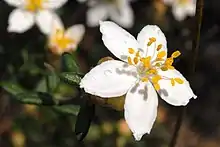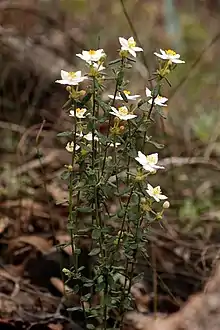| Bindoon starbush | |
|---|---|
 | |
| Scientific classification | |
| Kingdom: | Plantae |
| Clade: | Tracheophytes |
| Clade: | Angiosperms |
| Clade: | Eudicots |
| Clade: | Rosids |
| Order: | Sapindales |
| Family: | Rutaceae |
| Genus: | Asterolasia |
| Species: | A. nivea |
| Binomial name | |
| Asterolasia nivea (Paul G.Wilson) Paul G.Wilson[1] | |
| Synonyms[1] | |
|
Urocarpus niveus Paul G.Wilson | |

Asterolasia nivea, commonly known as Bindoon starbush,[2] is a species of weak sub-shrub that is endemic to the southwest of Western Australia. It has leathery oblong to narrow elliptical leaves and white flowers arranged in groups of about three flowers with thick-centred, shield like, star-shaped hairs on the back of the petals.
Description
Asterolasia nivea is a weak sub-shrub that typically grows to a height of about 50 cm (20 in). The leaves are narrow oblong, to elliptical, about 12 mm (0.47 in) long on a short petiole. The leaves are covered with star-shaped hairs. The flowers are arranged in groups of about three in leaf axils and on the ends of branchlets, each flower on a pedicel up to 15 mm (0.59 in) long and covered with thick-centred, star-shaped hairs. The petals are white, elliptical, 8–10 mm (0.31–0.39 in) long with thick-centred, star-shaped hairs on the back that formed a shield over the flower bud. There are between fifteen and twenty stamens.[2]
Taxonomy
This species was first formally described in 1980 by Paul Wilson who gave it the name Urocarpus niveus and published the description in the journal Nuytsia.[3] In 1987, Wilson changed the name to Asterolasia nivea, publishing the change in the journal Nuytsia.[4][5]
In 2017, Juliet A. Wege published a paper in Nuytsia suggesting that A. nivea is a white flowered form, and that the name A. nivea is a synonym of A. grandiflora. This change has been accepted by the Western Australian Herbarium but not as yet by the Australian Plant Census.[1][6][7]
Distribution and habitat
Asterolasia nivea grows in gravel between New Norcia and Bindoon in Western Australia.[2]
References
- 1 2 3 "Asterolasia nivea". Australian Plant Census. Retrieved 28 June 2020.
- 1 2 3 Wilson, Paul G. "Asterolasia nivea". Australian Biological Resources Study, Department of Agriculture, Water and the Environment, Canberra. Retrieved 28 June 2020.
- ↑ "Urocarpus niveus". APNI. Retrieved 28 June 2020.
- ↑ "Asterolasia nivea". APNI. Retrieved 28 June 2020.
- ↑ Wilson, Paul Graham (1987). "The names Asterolasia F. Muell. and Urocarpus Harvey (Rutaceae)". Nuytsia. 6 (1): 8. Retrieved 28 June 2020.
- ↑ Wege, Juliet A. (2017). "Taxonomic notes on Asterolasia (Rutaceae) in Western Australia to inform conservation" (PDF). Nuytsia. 28: 141–143. Retrieved 28 June 2020.
- ↑ "Asterolasia nivea". FloraBase. Western Australian Government Department of Biodiversity, Conservation and Attractions.